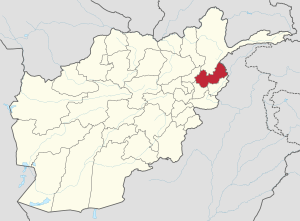Nuristani languages
| Nuristani | |
|---|---|
| Geographic distribution: | Nuristan |
| Linguistic classification: |
|
| Glottolog: | nuri1243[1] |
|
Nuristan province in Afghanistan, where most speakers live | |
The Nuristani languages (نورستاني) are one of the three groups within the Indo-Iranian language family, alongside the much larger Indo-Aryan and Iranian groups.[2][3][4] They have approximately 130,000 speakers primarily in eastern Afghanistan and a few adjacent valleys in Khyber Pakhtunkhwa's Chitral District, Pakistan. The region inhabited by the Nuristanis is located in the southern Hindukush mountains, and is drained by Alingar River in the west, Pech River in the center, and Landai Sin and Kunar River in the east.
The languages were often confused with one another before they were considered a third branch in Indo-Iranian. That accounted for many Burushaski loanwords present in Dardic.
Languages
- Askunu (Ashkun) 40,000 speakers
- Kamkata-viri (Bashgali, includes the dialects Kata-vari, Kamviri and Mumviri) 40,000 speakers
- Vasi-vari (Prasuni) 8,000 speakers
- Tregami (Gambiri) 3,500 speakers
- Waigali (Kalasha-ala) 12,000 speakers
- Zemiaki 500 speakers
History
The Nuristani languages were not described in the literature until the 19th century. The older name for the region was Kafiristan and the languages were termed Kafiri or Kafiristani, but the terms have been replaced by the present ones since the conversion of the region to Islam in 1896.
There are three different theories about the origins of the Nuristani languages and their place within the Indo-Iranian languages:
- following the studies of Georg Morgenstierne, Nuristani has generally been regarded as one of three primary sub-groups of Indo-Iranian (alongside Iranian and Indo-Aryan);
- suggestions that Nuristani may instead be a branch of the Indo-Aryan subgroup, due to the evident influence of Dardic languages, and;
- it has also been proposed that Nuristani originated within the Iranian sub-group, and was later influenced by an Indo-Aryan language, such as Dardic.
The languages are spoken by tribal peoples in an extremely isolated mountainous region of the Hindu Kush, one that has never been subject to any real central authority in modern times. This area is located along the northeastern border of Afghanistan and adjacent portions of the northwest of present-day Pakistan. These languages have not received the attention Western linguists like to give them. Considering the very small number of peoples estimated to speak them, they must be considered endangered languages.
Georg Morgenstierne wrote that Chitral in Pakistan is the area of the greatest linguistic diversity in the world. Although Khowar is the predominant language of Chitral and northwestern Pakistan, more than ten other languages are spoken here. These include Kalasha-mun, Palula, Dameli, Gawar-Bati, Nuristani, Yidgha, Burushaski, Gujar, Wakhi, Kyrgyz, Dari and Pashto. Since many of these languages have no written form, they are usually written in an ad hoc Arabic alphabet.
Many Nuristani people now speak other languages, such as Dari and Pashto (two official languages of Afghanistan) and Chitrali in Pakistan.
Features
The earliest divergence of Nuristani from the other Indo-Iranian languages may be indicated by the failure of the Ruki sound law to apply after *u: e.g. Kam-viri /muˈsə/ 'mouse'.
Nuristani shares with Iranian the merger of the plain and breathy voiced consonants, and the fronting of the Proto-Indo-Iranian primary palatal consonants. The latter were retained as dental affricates in Proto-Nuristani, in contrast to simplification to sibilants (in most of Iranian) or interdentals (in Persian). Later on *dz has however shifted to /z/ in all Nuristani varieties other than Kam-viri and Tregami.
Many Nuristani languages have subject–object–verb (SOV) word order, like most of the other Indo-Iranian languages, and unlike the adjacent Dardic Kashmiri language, which has verb-second word order.
Literature
- Decker, Kendall D. (1992) Languages of Chitral. Sociolinguistic Survey of Northern Pakistan, 5. Islamabad: National Institute of Pakistan Studies, Quaid-i-Azam University and Summer Institute of Linguistics.
- Grjunberg, A. L. (1971): K dialektologii dardskich jazykov (glangali i zemiaki). Indijskaja i iranskaja filologija: Voprosy dialektologii. Moscow.
- Morgenstierne, Georg (1926) Report on a Linguistic Mission to Afghanistan. Instituttet for Sammenlignende Kulturforskning, Serie C I-2. Oslo. ISBN 0-923891-09-9
- Jettmar, Karl (1985) Religions of the Hindu Kush ISBN 0-85668-163-6
- J. P. Mallory, In Search of the Indo-Europeans: Language, Archaeology and Myth, Thames and Hudson, 1989.
- James P. Mallory & Douglas Q. Adams, "Indo-Iranian Languages", Encyclopedia of Indo-European Culture, Fitzroy Dearborn, 1997.
- Strand, Richard F. "NURESTÂNI LANGUAGES" in Encyclopædia Iranica
References
- ↑ Hammarström, Harald; Forkel, Robert; Haspelmath, Martin; Bank, Sebastian, eds. (2016). "Nuristani". Glottolog 2.7. Jena: Max Planck Institute for the Science of Human History.
- ↑ SIL Ethnologue
- ↑ Morgenstierne, G. Irano-Dardica. Wiesbaden 1973; Morgenstierne, G. "Die Stellung der Kafirsprachen". In Irano-Dardica, 327–343. Wiesbaden, Reichert 1975
- ↑ Strand, Richard F. (1973) "Notes on the Nûristânî and Dardic Languages." Journal of the American Oriental Society, 93(3): 297–305.
See also
External links
- Reiko and Jun's Japanese Kalash Page
- Hindi/Urdu-English-Kalasha-Khowar-Nuristani-Pashtu Comparative Word List
- Richard Strand's Nuristân Site This site is the primary source on the linguistics and ethnography of Nuristân and neighboring regions, collected and analyzed over the last forty years by the leading scholar on Nuristân.
